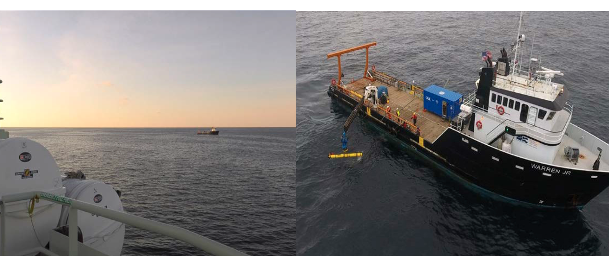Shelfbreak Productivity Interdisciplinary Research
Dennis McGillicuddy, Applied Ocean Physics and Engineering, Woods Hole Oceanographic Institution, Woods Hole, MA, USA. Extracted from OOI Science Plan, 2021.
The continental shelfbreak of the Mid-Atlantic Bight supports a productive and diverse ecosystem. Current paradigms suggest that this productivity is driven by several upwelling mechanisms at the shelfbreak front. This upwelling supplies nutrients that stimulate primary production by phytoplankton, which in turn leads to enhanced production at higher trophic levels. Although local enhancement of phytoplankton biomass has been observed in some synoptic measurements, such a feature is curiously absent from time-averaged measurements, both remotely sensed and in situ. Why would there not be a mean enhancement in phytoplankton biomass as a result of the upwelling? One hypothesis is that grazing prevents accumulation of biomass on seasonal and longer time scales, transferring the excess production to higher trophic levels and thereby contributing to the overall productivity of the ecosystem. However, another possibility is that the net impact of these highly intermittent processes is not adequately represented in long-term means of the observations, because of the relatively low resolution of the in situ data and the fact that the frontal enhancement can take place below the depth observable by satellite.
A unique opportunity to test these hypotheses has arisen with deployment of the OOI Pioneer Array south of New England. The combination of moored instrumentation and mobile assets (gliders, AUVs) is yielding observations of the frontal system with unprecedented spatial and temporal resolution. This provides an ideal four-dimensional (space-time) context in which to conduct a detailed study of frontal dynamics and plankton communities needed to test the aforementioned hypotheses.
The Shelfbreak Productivity Interdisciplinary Research Operation at the Pioneer Array (SPIROPA) project has carried out a set of three cruises (Fig. to the right) to obtain cross-shelf sections of physical, chemical, and biological properties within the Pioneer Array. On the first and third of these, voyage 29 of the R/V Neil Armstrong and voyage 368 of the R/V Thomas G. Thompson, we carried out two-ship operations with the R/V Warren Jr. from which OOI was deploying a REMUS 600 AUV as part of their routine observations. Coordination of these deployments with our field work provided tremendous opportunity for adaptive sampling. Immediately following recovery of the AUV, the data were uploaded to the OOI server on shore, from which the SPIROPA team could download it at the very same moment the entire world had access to the same data. Having these ultra-high-resolution measurements from the AUV at our fingertips improved our ability to resolve the fine-scale variability characteristic of the front, and target our shipboard measurements of biological “hotspots.” A short video describing the two-ship operation with voyage #29 of the R/V Neil Armstrong is available here.
Mini-documentaries (~10 min each) of the SPIROPA voyages are also available:

